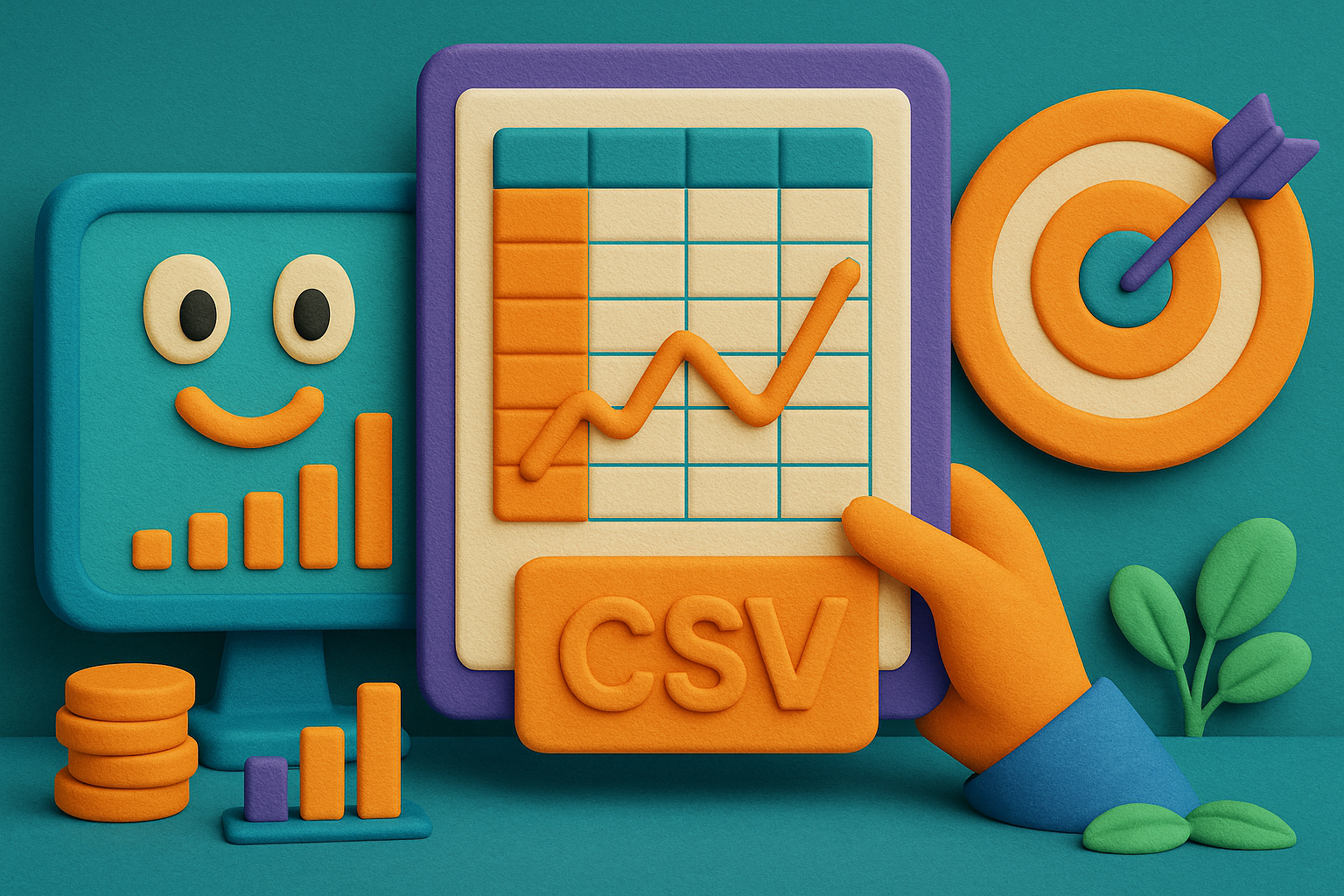
Best Practices for Resume Data Export and CSV Management
Best Practices for Resume Data Export and CSV Management
Published on November 8, 2025 · Q&A format · Practical guide to handling candidate data exports without losing your mind (or your data).

Q: Why do CSV exports still matter when everything's moving to APIs?
Because hiring managers and executives love spreadsheets. They want to pivot table their way through candidate data, share reports with stakeholders who don't have ATS access, and do custom analysis in Excel. Plus, not every tool integrates with everything—sometimes CSV is your only bridge between systems.
In 2025, CSVs are the universal language of business data. Your ATS might speak JSON, but your CFO speaks Excel. Learn to manage CSVs well, and you become the hero who gets data where it needs to go.
Also, CSV exports are often your backup plan when APIs fail, rate limits hit, or you need to migrate to a new ATS. They're unglamorous but essential.
Q: What's the biggest mistake people make with resume data exports?
Not standardizing field names and formats upfront. You export from your ATS and get columns like candidate_name, then export from your screening tool and get full_name, then your interview scheduling tool calls it applicant.
Three months later, you have five different CSVs that can't be merged without manual cleanup. Nightmare fuel for data teams.
Fix: Create a master data dictionary early. Define standard field names (candidate_id, full_name, email, phone, application_date, etc.) and make every export conform to it. Use transformation scripts or tools like Zapier Formatter to normalize on import.
Q: What fields should every resume export CSV include at minimum?
The non-negotiables:
- Unique ID:
candidate_idorapplication_id(critical for deduplication and joins) - Personal info:
full_name,email,phone - Job context:
job_title,job_id,department - Timestamps:
application_date,last_updated(ISO 8601 format:2025-11-08T14:32:00Z) - Status:
stage(Applied, Screening, Interview, Offer, Rejected) - Source:
source(LinkedIn, Indeed, Referral, Direct) - Score/Rating:
ai_score,recruiter_rating(if applicable)
Optional but super useful: resume_url, linkedin_url, skills_matched, experience_years, education_level, location, salary_expectation.
Q: How do I handle special characters and international names without corrupting data?
This is where people lose data. Names like "François Müller" or "李明" get mangled if you're not careful with character encoding.
Golden rule: Always use UTF-8 encoding.
- When exporting: Specify UTF-8 (most modern tools default to this, but verify)
- When opening in Excel: Use "Data → From Text/CSV" and select UTF-8, not double-clicking the file (which uses system encoding and often breaks)
- In code: Python:
pd.read_csv('file.csv', encoding='utf-8'), Node:fs.readFileSync('file.csv', 'utf8')
Excel gotcha: If you must double-click to open, save as "CSV UTF-8 (Comma delimited)" not "CSV (Comma delimited)"—they're different in Excel 2019+.
Also, watch out for commas in names like "Doe, John" or company names like "Smith, Jones & Associates"—always wrap text fields in quotes when exporting.
Q: What's the best way to structure multi-value fields like skills or certifications?
You have three options, each with trade-offs:
Option 1: Pipe-delimited within one cell (most common)
- Example:
Python | React | SQL | Docker - Pros: One row per candidate, easy to read
- Cons: Hard to filter/query in Excel, requires string splitting in code
Option 2: Separate boolean columns
- Example:
has_python,has_react,has_sql(TRUE/FALSE) - Pros: Easy filtering, pivot tables work great
- Cons: Wide tables (100+ columns if many skills), doesn't scale to open-ended skills
Option 3: Separate skills table (normalized)
- Export two CSVs:
candidates.csvandcandidate_skills.csv(withcandidate_idforeign key) - Pros: Properly normalized, flexible, easy to query in databases
- Cons: Requires joins, confuses non-technical users
Recommendation: Option 1 for hiring manager reports (simple), Option 3 for analytics/BI tools (powerful).
Q: How do I automate weekly/monthly candidate reports without manual exports?
Set up scheduled exports in your ATS or build a simple automation:
Method 1: ATS scheduled exports (Greenhouse, Lever, etc.)
- Most ATSs let you schedule CSV exports via email or SFTP
- Configure filters (e.g., "all candidates from last 7 days")
- Auto-emails to hiring@company.com every Monday at 9 AM
Method 2: API + cron job (more flexible)
- Script calls your ATS API every week
- Fetches candidate data, transforms to your standard format
- Generates CSV and uploads to Google Drive/Dropbox
- Sends Slack notification with link
Method 3: No-code automation (Zapier/Make)
- Trigger: Schedule (every Monday 9 AM)
- Action: ATS API call → Fetch candidates
- Action: Format as CSV (use Google Sheets as intermediate step)
- Action: Email to hiring manager with attachment
Budget 30-60 minutes to set up once, then it runs forever. Way better than manually exporting every week.
Q: How do I merge data from multiple sources (ATS, screening tool, interview platform) into one CSV?
This is where candidate_id or email as a key becomes critical. The process:
Step 1: Export from each system
- ATS export:
candidates.csv(name, email, application_date, job, stage) - Screening tool:
scores.csv(email, ai_score, skills_matched) - Interview tool:
interviews.csv(email, interview_date, interviewer, result)
Step 2: Join on common key (email or candidate_id)
- Excel: Use VLOOKUP or Power Query merge
- Python:
pd.merge(candidates, scores, on='email', how='left') - Google Sheets:
=VLOOKUP(A2, scores!A:D, 3, FALSE) - SQL:
SELECT * FROM candidates LEFT JOIN scores ON candidates.email = scores.email
Step 3: Handle mismatches
- Email variations (john.doe@gmail vs johndoe@gmail) → normalize before joining
- Missing data → decide on nulls vs default values
- Duplicates → dedup based on most recent timestamp
Pro tip: If you're doing this regularly, build a Python/Node script that automates the whole pipeline. 50 lines of code saves hours of manual work.
Q: What's the best way to handle date/time formatting across different systems?
Dates are a nightmare in CSVs because everyone formats differently:
- US:
11/08/2025 - EU:
08/11/2025 - ISO:
2025-11-08 - Full:
November 8, 2025 - Timestamp:
1699459200(Unix epoch)
Solution: Always use ISO 8601 format in exports.
- Date only:
YYYY-MM-DD(e.g.,2025-11-08) - Date + time:
YYYY-MM-DDTHH:MM:SSZ(e.g.,2025-11-08T14:32:00Z)
This is unambiguous, sorts correctly, and every programming language can parse it. When importing to Excel, it auto-converts to local format for display but stores properly underneath.
If you receive non-ISO dates, convert immediately: Python's dateutil.parser.parse() or JavaScript's new Date() handle most formats, then re-export as ISO.
Q: How do I prevent Excel from auto-corrupting phone numbers and IDs?
Classic Excel move: 0123456789 becomes 123456789 (drops leading zero), or 123-45-6789 becomes a date formula. SSNs, international phone numbers, and order IDs all get wrecked.
Fix 1: Prefix with single quote in CSV
- Export phone as
'0123456789(the quote tells Excel "treat as text") - Works but looks weird when users edit the cell
Fix 2: Use tab-delimited (TSV) instead of CSV
- Excel less aggressive with auto-formatting in TSV files
- Same structure, just
\tinstead of,as delimiter
Fix 3: Add a column format hint
- Some tools let you specify "phone is text, not number" in export settings
- Greenhouse, Workday, and modern ATSs support this
Fix 4: Educate users on proper CSV opening
- Never double-click CSV files in Excel
- Use "Data → From Text/CSV" and set column types manually
- Annoying but foolproof
Q: Should I include personally identifiable information (PII) in exports?
Depends on who's receiving the export and why.
For internal hiring managers: Yes, include name, email, phone—they need it to contact candidates.
For analytics/reporting to execs: Anonymize. Replace names with candidate_001, hash emails, remove phone numbers. They only need aggregate stats, not personal data.
For third-party tools (BI, data warehouses): Minimal PII. Use candidate IDs, aggregate data, and never include SSN, date of birth, or sensitive fields.
For external partners (recruiting agencies, etc.): Only include data covered by your contracts and NDAs. Default to less data, not more.
GDPR compliance: If candidates are in EU/UK, document what data you export, why, and how long you retain it. Candidates have the right to request deletion—make sure you can purge from exports too.
Q: What's the best tool for cleaning and transforming messy CSV data?
Depends on your skills and scale:
Non-coders:
- OpenRefine: Free, powerful, visual interface for cleaning. Handles millions of rows, smart deduplication, clustering, regex.
- Excel Power Query: Built into Excel 2016+. Great for transformations, merges, and pivots.
- Google Sheets + add-ons: "Remove Duplicates" and "Trim Whitespace" add-ons cover 80% of cleanup needs.
Coders:
- Python + Pandas: Industry standard.
pd.read_csv(), clean, transform,df.to_csv(). Handles gigabyte-scale files. - csvkit: Command-line tools (
csvcut,csvjoin,csvgrep) for quick transforms without writing code. - Node.js + csv-parser: Good for streaming huge files without loading into memory.
For one-off cleanup: OpenRefine. For recurring pipelines: Python script.
Q: How do I version control my candidate data exports?
CSVs change over time as candidates progress through stages. You need a history for audits, rollbacks, and trend analysis.
Simple approach: Timestamped filenames
candidates_2025-11-08.csv,candidates_2025-11-15.csv, etc.- Store in Google Drive/Dropbox with version history enabled
- Works for small teams, easy to understand
Better approach: Git + DVC (Data Version Control)
- Git for metadata and scripts, DVC for large CSV files
- Full history, diffs between versions, rollback capability
- Overkill for most recruiting teams, but perfect for data-heavy orgs
Best approach: Database with audit log
- Import CSVs to PostgreSQL/MySQL with timestamp columns
- Run queries for "show me all candidates as of November 1st"
- Audit trail built-in, point-in-time recovery, fast queries
Pick based on team size and technical chops. For most: timestamped files + cloud storage is good enough.
Q: Can I use CSVs to migrate data from one ATS to another?
Yes, but it's tricky. ATS migration via CSV usually goes like this:
Step 1: Export everything from old ATS
- Candidates, jobs, applications, notes, attachments, interview feedback
- You'll get 5-10 different CSV files linked by IDs
Step 2: Map old schema to new ATS schema
- Old ATS calls it
candidate_stage, new one calls itapplication_status - Create transformation script to map field names and values
Step 3: Clean and deduplicate
- Fix encoding issues, remove duplicates, fill missing required fields
Step 4: Import to new ATS
- Most ATSs have bulk import tools that accept CSV
- Test with 10 records first, then scale up
- Expect 5-10% of records to fail—manual cleanup required
Step 5: Migrate attachments separately
- Resumes, cover letters, interview notes usually can't go via CSV
- Use API or SFTP for file transfers
Budget 2-4 weeks for a full migration (500+ candidates). It's doable but not trivial.
Q: How do I generate CSV reports that non-technical hiring managers actually want?
Ask them first! But common requests:
- Weekly pipeline report: Stage breakdown (Applied: 50, Screening: 20, Interview: 10, Offer: 2)
- Time-to-hire by role: Average days from application to offer, grouped by job title
- Source effectiveness: Which job boards/referrals produce best candidates (score, conversion rate)
- Diversity metrics: Gender/ethnicity breakdown at each stage (if you collect this data)
- Rejection reasons: Why candidates didn't advance (skills mismatch, location, salary, etc.)
Make them visual: Use color-coded cells (green/yellow/red for metrics), charts, and conditional formatting. Excel boring pivot tables → beautiful dashboards.
Include a summary row at the top with key metrics: Total applicants, Average score, Top skill gap, Time-to-fill. Busy managers read the first row and decide if they need to dig deeper.
Q: What are the performance limits—how big can a CSV get before tools break?
Practical limits in 2025:
- Excel: 1,048,576 rows max, but gets sluggish after 100K. Use Power Query for bigger data.
- Google Sheets: 10 million cells max (e.g., 100K rows × 100 columns). Slow after 50K rows.
- Python Pandas: Depends on RAM. 8GB laptop handles ~1M rows comfortably. Use
chunksizefor bigger files. - Database import: PostgreSQL, MySQL handle billions of rows. No practical limit for recruiting use cases.
If you're hitting 100K+ candidate records, stop using spreadsheets for analysis. Move to a proper database or BI tool (Tableau, Metabase, Looker). CSVs are for export/transfer, not analysis at scale.
Q: How do I schedule automated CSV backups of candidate data?
Your ATS should be doing this, but don't trust it blindly. Set up your own:
Daily backup script (Python example):
- Call ATS API
- Fetch all candidates modified in last 24 hours
- Append to
backup_YYYY-MM-DD.csv - Upload to S3/Google Cloud Storage with versioning enabled
- Slack notification if backup fails
Run as a cron job (Linux) or Task Scheduler (Windows) every night at 2 AM. Costs ~$0.50/month in storage for years of backups.
Why bother? ATS vendors go down, acquisitions happen, data gets corrupted. Your backup might save your job someday.
Q: What's the future of CSV for recruiting—are we moving beyond it?
CSVs aren't going anywhere soon, but they're evolving:
- JSON/Parquet replacing CSV for APIs: More structured, handles nested data better, faster to parse.
- Real-time data streams: Webhooks + event-driven architectures replace batch exports for operational data.
- Embedded BI dashboards: Instead of emailing CSVs, share live Tableau/Looker links with auto-refresh.
- Natural language queries: "Show me Python developers who applied this week" → AI generates the report, no CSV needed.
But for ad-hoc analysis, executive reports, and cross-tool data transfer? CSV will outlive us all. It's the cockroach of data formats—ugly, but unkillable.
Need clean, structured candidate data? Our AI resume screening tool exports to CSV with standardized fields, UTF-8 encoding, and ISO date formats—ready to merge with your ATS data.
Related reading
- How to Build Custom Resume Screening Workflows with No-Code Tools
- Best Practices for Bulk Resume Processing via API
- Why RESTful API Resume Screening Beats Manual Processing
Join the conversation
Ready to experience the power of AI-driven recruitment? Try our free AI resume screening software and see how it can transform your hiring process.
Join thousands of recruiters using the best AI hiring tool to screen candidates 10x faster with 100% accuracy.
Related Articles
How to Automate Resume Screening with Zapier Integration
Stop manually screening resumes. This practical Q&A shows you how to connect AI recruitment software to your hiring work...
Why RESTful API Resume Screening Beats Manual Processing
Still manually reviewing hundreds of resumes? This Q&A breaks down why RESTful APIs are crushing manual screening in 202...
How Video Resume Screening with AI Changes Hiring in 2025
Video resumes analyzed by AI recruitment software are changing how companies evaluate candidates in 2025. This Q&A expla...
What Conversational AI Resume Screening Looks Like in Practice
Conversational AI resume screening transforms candidate experience with 24/7 chatbot interactions, instant feedback, and...
How Startups Screen Resumes on Zero Budget: Complete Guide
Pre-revenue startup with no hiring budget? This Q&A shows you how to screen 200+ resumes/year using 100% free tools—AI r...
Why Skills-Based Resume Screening Outperforms Degree-Based Filtering
Still filtering resumes by college degrees? This Q&A breaks down why skills-based screening finds better candidates, red...
From the forum
Popular Posts
Free AI Resume Screening Software That Actually Works
Best Free AI Resume Screening Software 2025
How AI-Powered Resume Screening Reduces Hiring Time by 90% While Maintaining Quality Candidates
How Free Resume Screening Software is Revolutionizing Small Business Hiring in 2025
Why Manual Resume Screening is Becoming Obsolete in 2025: The Complete Shift to Intelligent Hiring
Recent Posts

How Video Resume Screening with AI Changes Hiring in 2025
November 12, 2025

What Conversational AI Resume Screening Looks Like in Practice
November 12, 2025

How Startups Screen Resumes on Zero Budget: Complete Guide
November 11, 2025
Why Skills-Based Resume Screening Outperforms Degree-Based Filtering
November 11, 2025

Best Free vs. Premium Resume Screening: Complete 2025 Comparison
November 10, 2025